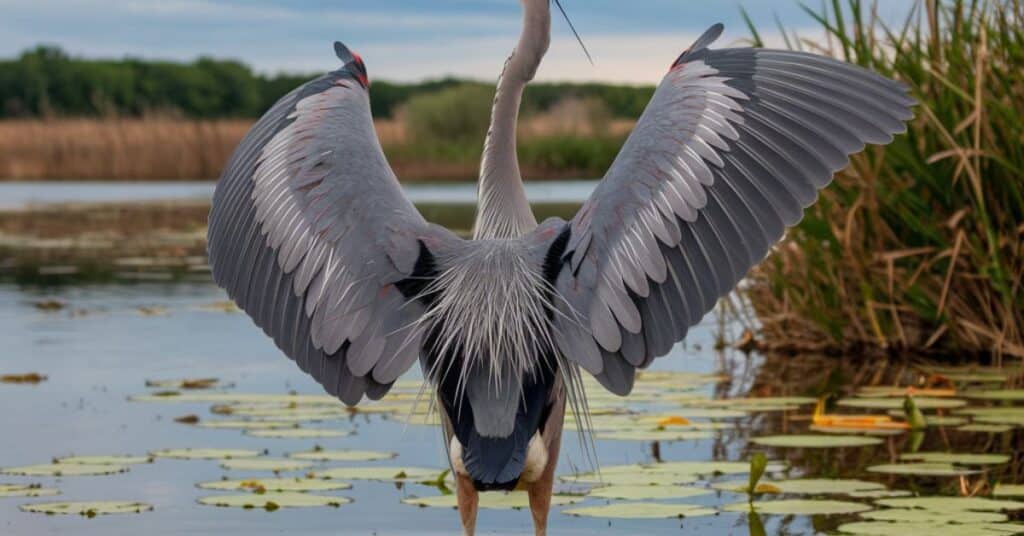Michigan’s diverse wetlands, lakes, and rivers provide ideal habitats for an impressive array of heron species. From the towering Great Blue Heron to the elusive Yellow-crowned Night-heron, these elegant birds captivate both seasoned birdwatchers and casual nature enthusiasts. In this comprehensive guide, we’ll explore the world of Michigan herons, diving deep into their unique characteristics, behaviors, and the best spots to observe them in their natural habitats.
Introduction: Michigan’s Wetland Wonders
The Great Lakes State boasts an intricate network of waterways, creating perfect conditions for various heron species and egrets in Michigan. These long-legged waders are more than just beautiful birds; they’re integral parts of our wetland ecosystems, serving as both predators and indicators of environmental health.
The diversity of herons in Michigan is truly remarkable, with eight distinct species calling our state home, either as year-round residents or seasonal visitors. Each of these birds has adapted to fill a unique ecological niche, showcasing nature’s incredible ability to evolve specialized traits and behaviors.
“Herons are the silent sentinels of our wetlands, their presence a testament to the health of our aquatic ecosystems.” – Dr. Emily Watkins, Michigan Ornithological Society
Let’s meet the magnificent eight Michigan heron species that grace our waters:
Meet the Magnificent Eight: Michigan’s Heron Species
Great Blue Heron: The Iconic Giant
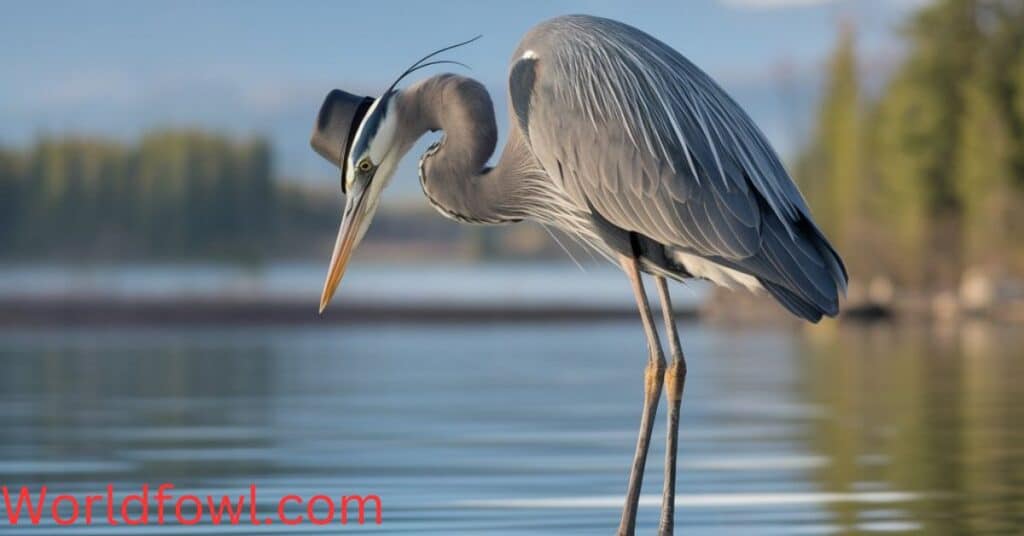
The Great Blue Heron (Ardea herodias) is arguably Michigan’s most recognizable wading bird. Standing up to 4.5 feet tall with a wingspan reaching 6.5 feet, these majestic birds are hard to miss
Fascinating facts:
- Great Blue Herons have specialized neck vertebrae that allow them to strike with lightning speed, spearing fish and other prey with pinpoint accuracy.
- Despite their large size, Great Blue Herons typically weigh only 5-6 pounds thanks to their hollow bones.
- These birds can fly at speeds up to 30 miles per hour during migration.
Diet and hunting behavior: Great Blue Herons are opportunistic feeders, consuming a wide variety of prey including:
- Fish (primary food source)
- Amphibians
- Reptiles
- Small mammals
- Other birds
Their hunting technique involves slowly wading through shallow water or standing motionless, waiting for prey to come within striking distance. When a target is spotted, the heron uses its quick reflexes and sharp bill to capture the unsuspecting victim.
Breeding and nesting: Great Blue Herons typically nest in colonies, called heronries, which can sometimes contain hundreds of nests. These colonies are often located in tall trees near water bodies. The nesting process follows these steps:
- Males arrive at breeding grounds first and select a nesting site.
- Females choose a mate based on the quality of the nesting site and the male’s displays.
- Both partners work together to build a large, platform-like nest using sticks.
- Females lay 2-6 pale blue eggs, which both parents incubate for about 28 days.
- Chicks fledge at around 7-8 weeks old but may continue to return to the nest for several more weeks.
Green Heron: The Stealthy Fisherman
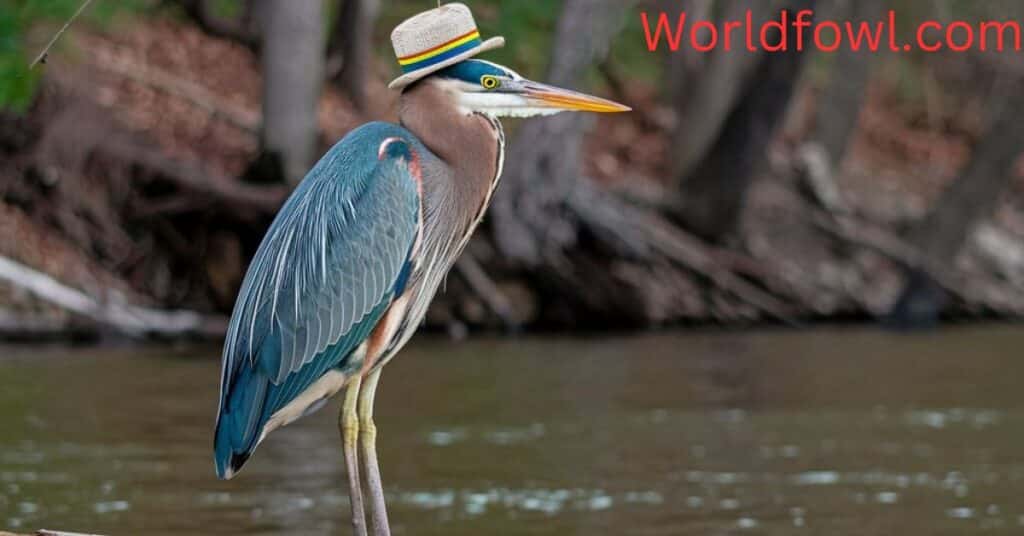
Don’t let its name fool you – the Green Heron (Butorides virescens) is a master of camouflage with its dark greenish-blue back and chestnut neck.
Key characteristics:
- Smaller size (16-18 inches tall)
- Stocky build
- Short legs
- Often holds neck tucked in
Green Herons prefer densely vegetated shorelines of ponds, streams, and wetlands. They’re known for their incredible intelligence, being one of the few tool-using birds in the world.
Tool use in Green Herons:
- Selects small twigs, insects, or feathers
- Drops “bait” onto water surface
- Waits patiently for fish to investigate
- Strikes with lightning speed to catch prey
This remarkable behavior demonstrates the Green Heron’s problem-solving abilities and adaptability. It’s a prime example of how these birds have evolved to maximize their hunting success in various environments.
Vocalizations: Green Herons have a distinctive call, often described as a sharp, explosive “skeow.” They may also produce a series of “kuk-kuk-kuk” sounds when alarmed or during territorial disputes.
Migration patterns: While some Green Herons in southern Michigan may stay year-round, most migrate south for the winter. Their migration routes can vary, with some birds traveling as far as Central America or the Caribbean. Factors influencing their migration include:
- Food availability
- Weather conditions
- Breeding success in previous seasons
Conservation status: Green Heron populations have experienced moderate declines in recent decades due to:
- Wetland habitat loss
- Water pollution
- Climate change impacts
Conservation efforts focusing on wetland restoration and water quality improvement are crucial for ensuring the long-term survival of this species in Michigan.
Black-crowned Night-heron: Twilight Hunter
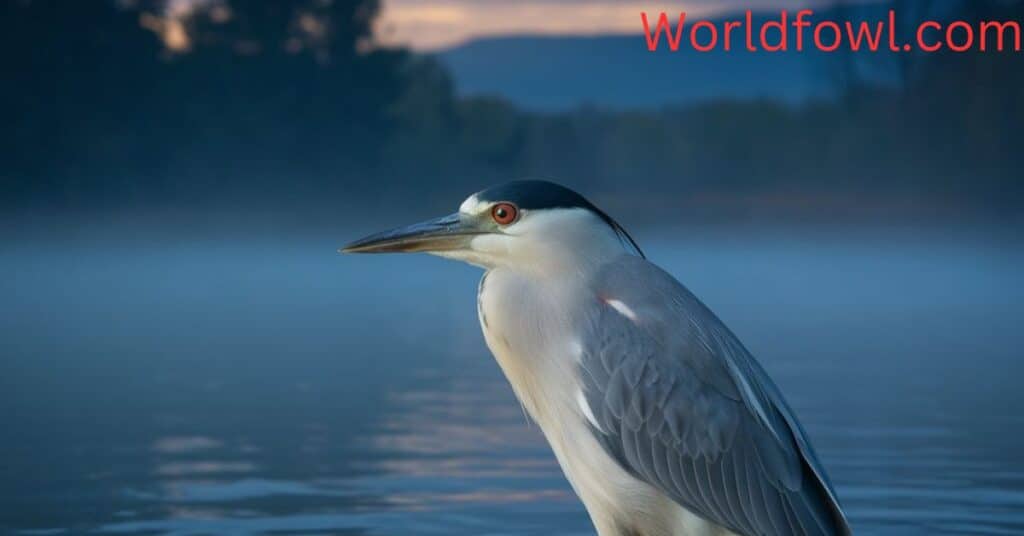
As its name suggests, the Black-crowned Night-heron (Nycticorax nycticorax) is most active during twilight and nighttime hours.
Distinctive features:
- Stocky build
- Large, red eyes
- Black cap and back
- Gray wings and white underparts
These herons in Michigan often form large breeding colonies in trees near water bodies. Their nocturnal habits and unique vocalizations – often described as a loud “quock” – make them an intriguing species to observe.
Did you know? Black-crowned Night-herons have exceptionally broad diets, consuming everything from fish and amphibians to small mammals and the young of other bird species.
Feeding behavior: Unlike many other herons, Black-crowned Night-herons are primarily nocturnal feeders. This adaptation allows them to exploit food resources that may be unavailable to diurnal species. Their feeding strategy typically involves:
- Perching motionless near the water’s edge
- Using their excellent night vision to spot prey
- Quickly striking to capture fish, amphibians, or invertebrates
Breeding colonies: Black-crowned Night-herons are highly social birds, often nesting in large, mixed-species colonies. These colonies can sometimes include hundreds of pairs and may also host other heron species, egrets, and ibises. The benefits of colonial nesting include:
- Increased protection from predators
- Enhanced ability to locate food sources
- Greater mating opportunities
Conservation challenges: While Black-crowned Night-herons are still relatively common in Michigan, they face several threats:
- Habitat loss due to wetland drainage and development
- Disturbance of breeding colonies by human activity
- Bioaccumulation of contaminants in their prey, affecting reproductive success
Conservation efforts should focus on protecting existing wetland habitats and minimizing disturbance to known breeding colonies.
Yellow-crowned Night-heron: The Rare Visitor
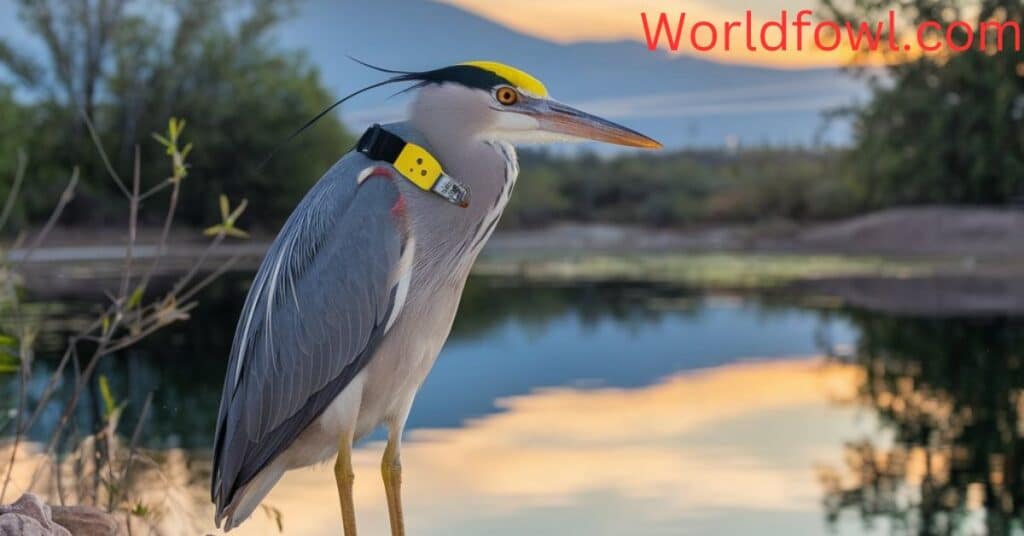
Show Image
The Yellow-crowned Night-heron (Nyctanassa violacea) is a rare treat for Michigan birdwatchers, as it’s at the northern edge of its range in our state.
How to identify:
- Slightly smaller than Black-crowned Night-heron
- Distinctive yellow crown and white cheek patch
- Long, decorative plumes on head during breeding season
While less common than its black-crowned cousin, the Yellow-crowned Night-heron can occasionally be spotted in southern Michigan, particularly in wetlands with abundant crayfish populations.
Crayfish specialists: These herons have evolved specialized bills perfect for crushing crayfish exoskeletons, their preferred prey.
Range expansion and climate change: In recent years, Yellow-crowned Night-herons have been observed more frequently in Michigan, possibly due to climate change. This northward range expansion may have both positive and negative consequences:
Pros:
- Increased biodiversity in Michigan wetlands
- New opportunities for birdwatchers and researchers
Cons:
- Potential competition with native species
- Uncertain long-term impacts on local ecosystems
Breeding behavior: Yellow-crowned Night-herons typically nest in small colonies or sometimes in isolation. Their nesting habits differ slightly from other heron species:
- They often choose urban or suburban areas for nesting, sometimes in close proximity to human activity.
- Nests are usually placed lower in trees compared to other herons, sometimes only 5-10 feet off the ground.
- Both parents share incubation duties and care for the young.
Conservation status: While not currently listed as threatened or endangered in Michigan, the Yellow-crowned Night-heron’s rarity in the state makes it a species of special concern. Conservation efforts should focus on:
- Protecting and restoring wetland habitats
- Monitoring population trends and range expansions
- Educating the public about the importance of urban wetlands and green spaces
Great Egret: Elegant White Wader
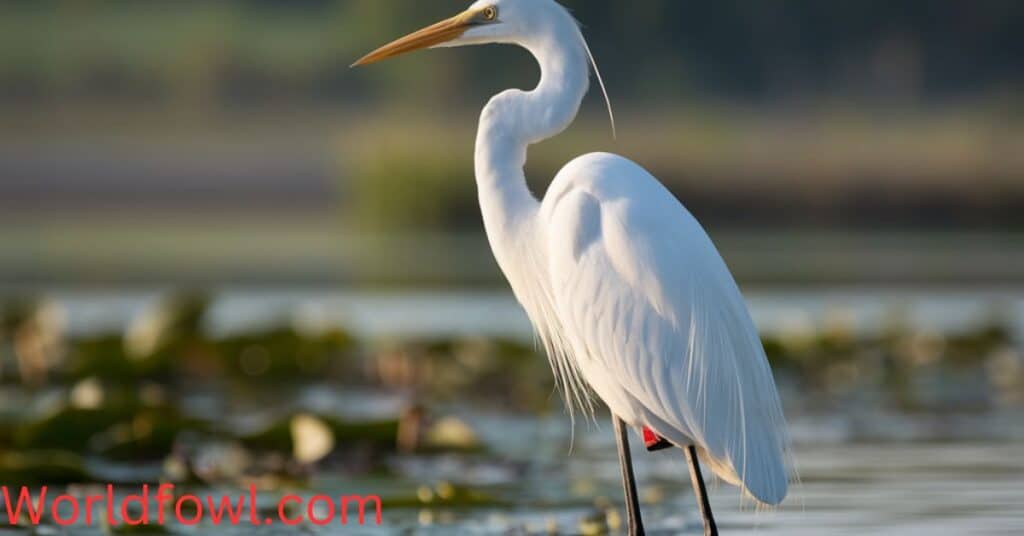
The Great Egret (Ardea alba) is a stunning, all-white heron that adds a touch of elegance to Michigan’s wetlands.
Key features:
- Pure white plumage
- Long, S-curved neck
- Yellow bill
- Black legs and feet
Once nearly hunted to extinction for their plumes, Great Egrets have made a remarkable comeback thanks to conservation efforts. They can now be found in wetlands across Michigan, particularly in the southern part of the state.
Feeding behavior: Great Egrets are skilled hunters, employing various techniques to catch their prey:
- Stand and wait: The most common method, where the bird remains motionless until prey comes within striking distance.
- Slow stalking: Moving slowly through shallow water, carefully lifting and placing each foot to avoid alerting prey.
- Wing flicking: Rapidly opening and closing their wings to startle fish, making them easier to catch.
Breeding displays: During the breeding season, Great Egrets undergo remarkable changes:
- Plumage: Long, filamentous feathers called aigrettes grow from their back, creating a stunning display.
- Bill color: The bill changes from yellow to a vibrant orange-red.
- Facial skin: The area around the eye turns a bright lime green.
These changes enhance their attractiveness to potential mates and play a crucial role in courtship displays.
Migration patterns: Great Egrets in Michigan are typically migratory, with most birds heading south for the winter. However, some individuals may remain year-round in areas with open water and adequate food supplies. Factors influencing their migration include:
- Temperature
- Ice cover on water bodies
- Food availability
Conservation challenges: While Great Egret populations have recovered significantly, they still face several threats:
- Habitat loss due to wetland drainage and development
- Water pollution affecting their prey base
- Climate change altering migration patterns and breeding habitats
Continued conservation efforts and habitat protection are essential to ensure the long-term success of this iconic species in Michigan.
Snowy Egret: The Dancing Fisherman
Show Image
The Snowy Egret (Egretta thula) is a smaller white heron known for its distinctive yellow feet and energetic fishing behavior.
Identification tips:
- All-white plumage
- Black bill with yellow base
- Black legs with bright yellow feet
- Shaggy plumes during breeding season
Snowy Egrets are less common in Michigan than Great Egrets, but they can be spotted in coastal areas and large wetland complexes, particularly during migration.
Animated fishing techniques:
- Foot stirring: Shuffling feet to stir up prey
- Wing flicking: Rapidly opening and closing wings to startle fish
- Canopy feeding: Extending wings to create shade, attracting fish
These diverse hunting methods showcase the Snowy Egret’s adaptability and intelligence. Their active foraging style contrasts sharply with the more patient approach of larger heron species.
Historical perspective: Like the Great Egret, Snowy Egrets were once heavily hunted for their plumes. By the early 20th century, their population had been reduced by 95%. The Migratory Bird Treaty Act of 1918 provided crucial protection, allowing their numbers to recover.
Breeding behavior: Snowy Egrets typically nest in mixed-species colonies, often alongside other herons, egrets, and ibises. Their breeding habits include:
- Nest construction: Both males and females participate in building the nest, which is usually a platform of sticks lined with finer materials.
- Courtship displays: Males perform elaborate courtship rituals, including stretching their necks, erecting their plumes, and presenting sticks to potential mates.
- Egg-laying: Females typically lay 3-5 pale blue-green eggs, which both parents incubate for about 24 days.
Conservation status in Michigan: Snowy Egrets are considered uncommon in Michigan, with most sightings occurring during migration. Conservation efforts should focus on:
- Protecting and restoring coastal wetlands and marshes
- Maintaining water quality in key stopover habitats
- Monitoring population trends and distribution patterns
Little Blue Heron: The Color-changing Trickster
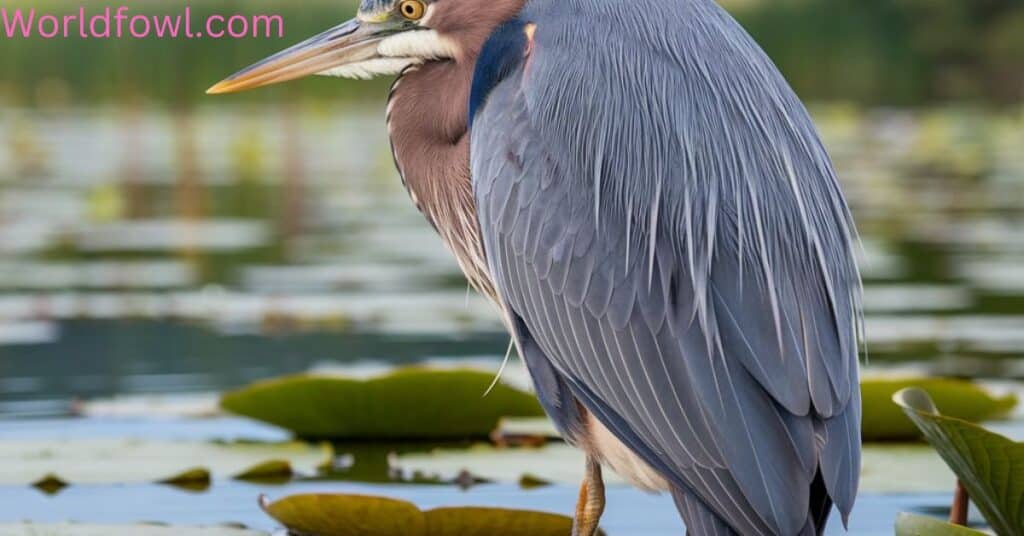
The Little Blue Heron (Egretta caerulea) is a fascinating species that undergoes a dramatic color change as it matures.
Range expansion factors:
- Climate change
- Habitat alterations
- Adaptability to human-modified environments
Feeding behavior: Little Blue Herons employ a variety of foraging techniques:
- Slow stalking: Carefully moving through shallow water in search of prey
- Stand and wait: Remaining motionless until prey comes within striking distance
- Probing: Using their bills to search for prey in muddy substrates
- Cooperative feeding: Sometimes forming loose feeding groups with other wading birds
Their diet consists primarily of small fish, amphibians, and aquatic invertebrates.
Breeding and nesting: Little Blue Herons typically nest in mixed-species colonies, often alongside other herons, egrets, and ibises. Their breeding habits include:
- Nest location: Usually in trees or shrubs over or near water
- Nest construction: Both partners participate in building the nest, which is a platform of sticks lined with finer materials
- Egg-laying: Females typically lay 3-5 pale blue-green eggs
- Incubation: Both parents share incubation duties, which last about 22-24 days
- Chick rearing: Young birds fledge at around 35-40 days old but may continue to be fed by parents for several more weeks
Conservation challenges in Michigan: As a species at the northern edge of its range in Michigan, Little Blue Herons face several challenges:
- Limited suitable habitat
- Competition with more established heron species
- Potential impacts of climate change on their northward expansion
Conservation efforts should focus on monitoring their population trends and protecting key wetland habitats that may support their continued range expansion.
Western Cattle Egret: The Landlubber
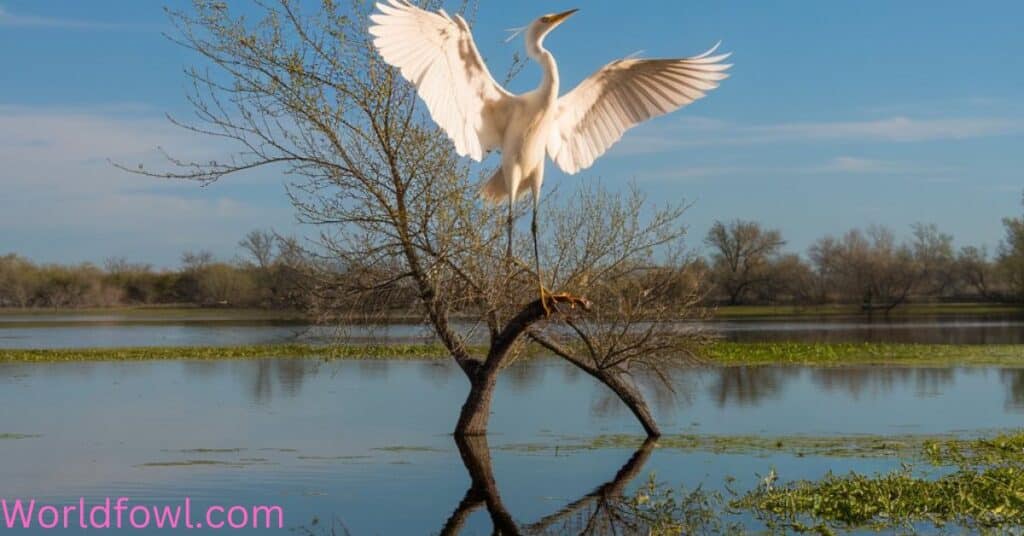
The Western Cattle Egret (Bubulcus ibis) is unique among Michigan’s herons
Symbiotic relationships: Cattle Egrets have developed mutually beneficial relationships with large grazing animals, including:
- Cattle (hence their name)
- Horses
- Bison
- Even farm machinery!
These relationships benefit both parties:
- The egrets get easy access to insects stirred up by the animals’ movements.
- The grazing animals benefit from reduced insect pest populations.
Breeding behavior: Cattle Egrets typically nest in colonies, often with other heron species. Their breeding habits include:
- Nest location: Usually in trees or shrubs, sometimes quite far from feeding areas
- Courtship displays: Males perform elaborate displays, including neck stretching, bill clapping, and twig shaking
- Egg-laying: Females typically lay 3-4 pale blue eggs
- Incubation: Both parents share incubation duties, which last about 22-26 days
- Chick rearing: Young birds fledge at around 30-35 days old
Conservation status in Michigan: Cattle Egrets are considered uncommon but established breeders in parts of Michigan. Their population trends and conservation needs differ from those of wetland-dependent herons:
- They benefit from certain types of agricultural practices that maintain open grasslands.
- However, intensification of agriculture and loss of pastureland can negatively impact their habitat.
- Climate change may influence their distribution and abundance in the state.
Heron Hotspots: Where to Find These Birds in Michigan
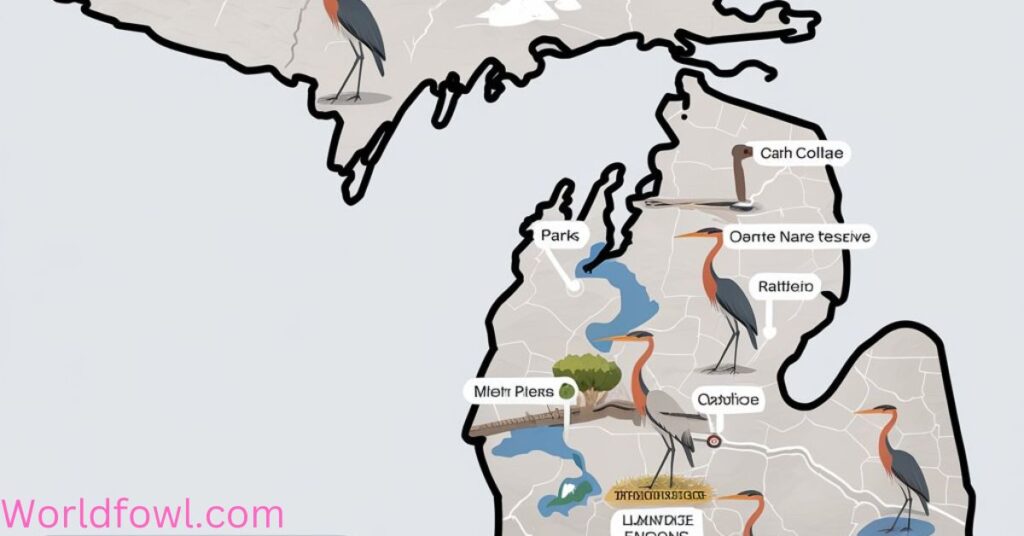
Michigan offers numerous excellent locations for observing herons and egrets. Here are some top spots to consider:
- Coastal marshes and wetlands
- Pointe Mouillee State Game Area
- Located at the mouth of the Huron River
- Known for diverse waterfowl and wading birds
- Best times: Spring and fall migrations
- Nayanquing Point Wildlife Area
- On Saginaw Bay
- Excellent for observing Great Blue Herons and Great Egrets
- Peak season: Late summer and early fall
- Wigwam Bay State Wildlife Area
- Located on Lake Huron
- Good for spotting Green Herons and Black-crowned Night-herons
- Best visited in early morning or late evening
- Pointe Mouillee State Game Area
- Inland lakes and rivers
- Kensington Metropark
- Features a nature center with heron rookery viewing opportunities
- Great for observing Great Blue Herons nesting
- Peak nesting season: March through July
- Seven Lakes State Park
- Diverse habitats including wetlands and small lakes
- Good for spotting Green Herons and occasional Great Egrets
- Year-round birding opportunities
- Sleepy Hollow State Park
- Features a 410-acre lake with surrounding wetlands
- Excellent for observing Great Blue Herons and Green Herons
- Kensington Metropark
Conservation Challenges and Successes
Michigan’s herons face several conservation challenges, but there have also been notable successes in protecting of Michigan herons
Challenges:
- Wetland loss and degradation
- Over 50% of Michigan’s original wetlands have been lost
- Impacts: Reduced habitat for feeding and nesting
- Causes: Urban development, agriculture, drainage projects
- Water pollution
- Sources: Agricultural runoff, industrial discharge, urban stormwater
- Effects: Reduced prey populations, bioaccumulation of toxins in herons
- Climate change impacts
- Altered migration patterns
- Changes in prey availability and distribution
- Increased frequency of extreme weather events affecting nesting success
- Human disturbance of nesting colonies
- Recreational activities near breeding sites
- Noise pollution from boats and watercraft
- Light pollution affecting nocturnal species
Success stories:
- Wetland restoration projects
- Example: Saginaw Bay Wetland Restoration Initiative
- Restored over 3,000 acres of wetland habitat
- Benefited multiple heron species and other wildlife
- Example: Saginaw Bay Wetland Restoration Initiative
- Improved water quality in many areas
- Great Lakes Water Quality Agreement
- Reduced levels of pollutants in the Great Lakes
- Improved health of fish populations, benefiting herons
- Great Lakes Water Quality Agreement
- Increased public awareness and appreciation
- Birding tourism contributing to local economies
- Citizen science projects engaging the public in heron conservation
How you can help:
- Support wetland conservation efforts
- Donate to organizations like Ducks Unlimited or Michigan Wetlands Association
- Volunteer for local wetland clean-up or restoration projects
- Participate in citizen science projects like eBird
- Report your heron sightings to contribute to scientific research
- Help track population trends and distribution patterns
- Reduce use of pesticides and fertilizers
- Opt for natural lawn care methods
- Create rain gardens to filter runoff
- Advocate for clean water policies
- Support legislation protecting wetlands and water quality
- Engage with local representatives on environmental issues
- Educate others about the importance of herons and their habitats
- Share your knowledge and experiences with friends and family
- Support nature education programs in schools and communities
Heron Watching Tips and Etiquette
To make the most of your heron-watching experience while minimizing disturbance to these sensitive birds, follow these guidelines:
- Best times for observation
- Early morning and late afternoon for most species
- Michigan herons are often most active during these periods
- Light conditions are usually best for photography
- Dusk and night for nocturnal species
- Use red-filtered flashlights to preserve night vision
- Early morning and late afternoon for most species
- Essential gear
- Binoculars (8×42 or 10×42 recommended)
- Provide a good balance of magnification and field of view
- Field guide or smartphone app for identification
- Merlin Bird ID or Sibley Birds are excellent options
- Camera with zoom lens (optional)
- Telephoto lenses allow for close-up shots without disturbing birds
- Weather-appropriate clothing
- Waterproof boots for wading in shallow water
- Muted colors to blend in with surroundings
- Binoculars (8×42 or 10×42 recommended)
- Respectful viewing practices
- Maintain a safe distance from birds and nesting areas
- Use the “field of view” rule: if the bird fills your binocular view, you’re too close
- Use designated viewing platforms and blinds when available
- These structures help minimize disturbance to wildlife
- Keep noise to a minimum
- Speak quietly and turn off cell phone ringers
- Maintain a safe distance from birds and nesting areas
By following these guidelines, you’ll not only enhance your own heron-watching experience but also contribute to the conservation of these magnificent birds and their habitats.
The Cultural Significance of Herons
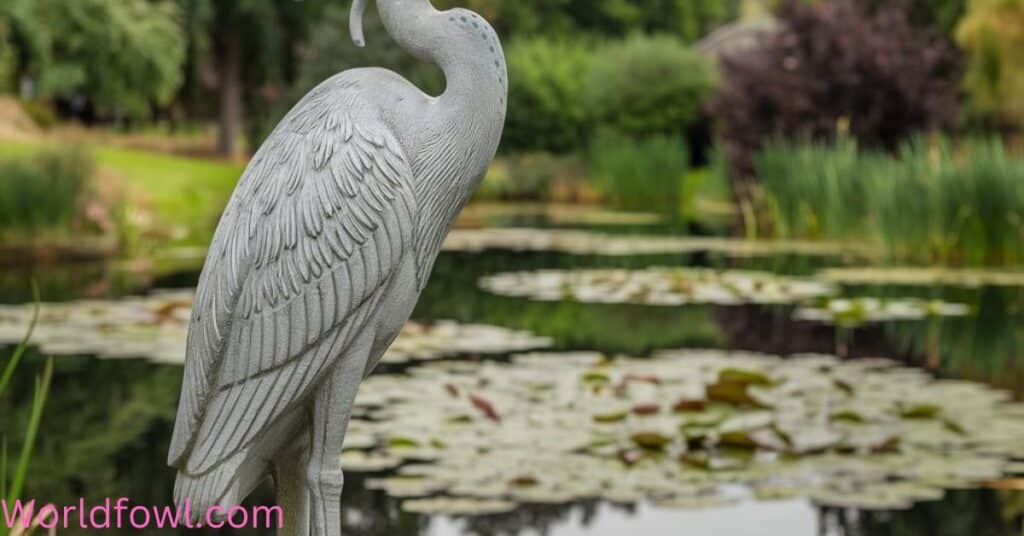
Michigan herons have long held a special place in human cultures, including those of Michigan’s indigenous peoples. Their graceful forms and patient hunting behaviors have inspired art, literature, and spiritual beliefs across many societies.
Herons in Michigan folklore: While specific Michigan folklore about herons is limited, many Great Lakes indigenous cultures incorporate these birds into their stories and traditions. For example:
- The Anishinaabe people have a clan system that includes a Heron Clan, associated with leadership and wisdom.
- Some Ojibwe stories feature the Great Blue Heron as a skilled hunter and fisher, teaching humans these important skills.
Modern cultural significance: In modern times, herons continue to inspire artists, writers, and conservationists. Their presence in our landscapes serves as a powerful reminder of the natural world’s beauty and fragility.
- Art and literature
- Herons frequently appear in Michigan wildlife art, symbolizing the state’s wetland heritage.
By understanding the cultural significance of herons, we can better appreciate their role not just in our ecosystems, but in our shared human experience. This deeper connection can inspire greater efforts to protect these magnificent birds and the habitats they depend on.
Conclusion:
From the majestic Great Blue Heron to the elusive Yellow-crowned Night-heron, Michigan’s eight heron species offer a fascinating glimpse into the diversity of our state’s wetland ecosystems. Each species has its own unique adaptations, behaviors, and ecological roles, contributing to the rich tapestry of life in our waterways.
By understanding and appreciating these remarkable birds, we can become better stewards of the habitats they depend on. Whether you’re a seasoned birder or a casual nature enthusiast, the sight of a heron patiently stalking its prey or taking flight with graceful wing beats is sure to leave a lasting impression.
As you explore Michigan’s waterways, keep an eye out for these elegant waders. Remember, every time you spot a heron, you’re witnessing a living link in the complex web of life that makes Michigan’s wetlands so vital and vibrant. Let’s work together to ensure these magnificent birds continue to thrive in our state for generations to come
By continuing to learn about, observe, and protect Michigan’s herons, we not only enrich our own lives but also contribute to the preservation of our state’s natural heritage. So grab your binoculars, head to a nearby wetland, and immerse yourself in the fascinating world of Michigan’s herons!
Additional Resources
To further your knowledge and appreciation of Michigan’s herons, check out these valuable resources:
- Field guides and apps
- Sibley Field Guide to Birds of Eastern North America
- Merlin Bird ID app by Cornell Lab of Ornithology
- Audubon Bird Guide app
- Local Audubon chapters and birding groups
- Michigan Audubon Society
- Detroit Audubon
- Kalamazoo Nature Center
- Wetland restoration volunteer opportunities
- Michigan Department of Natural Resources Volunteer Program
- Ducks Unlimited Michigan Chapter
- The Nature Conservancy in Michigan
- Reputable websites for further heron research
- Cornell Lab of Ornithology’s All About Birds
- Audubon Guide to North American Birds
- Michigan Department of Natural Resources Bird Watching
By engaging with these resources and getting out into nature, you’ll deepen your understanding and appreciation of Michigan’s magnificent herons and the crucial role they play in our state’s ecosystems. Happy heron watching!

Henry James is a seasoned blogger and a passionate storyteller on “World Fowl.” With years of experience crafting engaging content, he brings a unique blend of expertise and creativity to his writing. Henry specializes in exploring diverse topics with depth and clarity, captivating readers worldwide.

